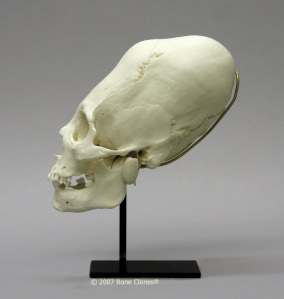 The picture on the left is a life-like cast of an artificially deformed skull from the former indigenous people of Peru. Permission to use the picture was granted by Bone Clones. I began my research into role of venous drainage problems in neurodegenerative diseases of the brain and cord about thirty years ago while studying an artificially deformed crania nearly identical to the one on the above. In addition to upper cervical strains, certain designs and deformation of the skull can affect the drainage system of the brain.
The picture on the left is a life-like cast of an artificially deformed skull from the former indigenous people of Peru. Permission to use the picture was granted by Bone Clones. I began my research into role of venous drainage problems in neurodegenerative diseases of the brain and cord about thirty years ago while studying an artificially deformed crania nearly identical to the one on the above. In addition to upper cervical strains, certain designs and deformation of the skull can affect the drainage system of the brain.
No one knows exactly why the former people of Peru and Bolivia chose to intentionally deform a child’s skull, but they did it to quite a few them. I won’t elaborate on all the different theories as to why they did it, nor will I offer my own theory at this time. For now, suffice it to say, what caught my attention was the altered shapes and open state of the special joints that link the bones of the cranial vault together called sutures. The sutures were so named by early anatomists because they are typically shaped like stitches. In contrast to stitches, if you click on the image you will see the sutures in the rear are smooth and open and don’t look like the usual stitch shapes. What’s more, this person was old enough that the sutures should have started to close on the inside.
In this case the severe deformation caused a change in the normal pitch and layout of the drainage system of the brain, including the dipolic veins. As you recall from previous posts, the diploic veins of the skull are located between the inner and outer layer of the skull bones. (See the picture above.)
The shapes of the sutures are actually similar to a seismic recording of fluid mechanics in the brain etched into the shapes of the bones. In the case of the artificially deformed skulls, the change in the shape of the skull caused chronic craniocervical venous back pressure and increased venous pressure in the diploic veins inside the diploe causing the sutures to stay open and altering their shapes.
There was still a hitch though. Except in some rare pathologies, the sutures of most skulls, even those associated with venous drainage problems, start to close on the inside regardless of whether or not they stayed open on the outside.
In some of the artificially deformed skulls, as in the example above, they were open all the way through and not even close to uniting. That suggested to me, that in addition to venous drainage problems, design problems and deformation of the of the skull can cause an increase in pressure inside the skull, called intracranial pressure (ICP). Aside from tumors and strokes, hydrocephalus in children causes an increase in the volume of CSF and ICP, which causes the sutures to stay open.
CSF flow as you recall flows from the ventricles in the core of the brain where it is produced, to the superior sagittal sinus vein at the top of the skull where it mixes with venous blood to exit the skull. Consequently, an increase in venous pressure in the superior sagittal sinus decreases the CSF pressure gradient, which decreases CSF flow. A decrease in CSF outflow increases CSF volume in the brain. The problem is that when adults get hydrocephalus later in life the sutures are closed so when CSF volume increases then either the brain or blood have got to decrease in volume. In this regard, the brain is more compressible than blood. The closed sutures also keep a cap on ICP similar to a counter-weight on a pressure cooker. Consequently, in contrast to children adults get low or normal pressure hydrocephalus (NPH).
The above skull shows how gross deformation of the skull can affect the venous drainage system. There are many different types of normal and pathological variations in the design of the skull, as well as different types of strains and deformation of the skull and spine. Some problems we inherit, others are acquired through disease, aging and injuries. Some are clearly visible, others are not so easily seen or recognized. One thing is becoming readily clear with modern MR angiograms, venograms and cine MR however; that is, strains and deformation of the upper cervical spine and base of the skull can cause chronic venous back pressure (edema), decreased arterial blood flow (ischemia) and decreased CSF flow, which has been linked to NPH, Alzheimer’s and Parkinson’s disease.
For more information on this and related topics visit my website at http://www.upright-health.com


Pingback: Skull Design and CCVBP | Alzheimer's, Parkinson's and Multiple … « mshelptoday.com